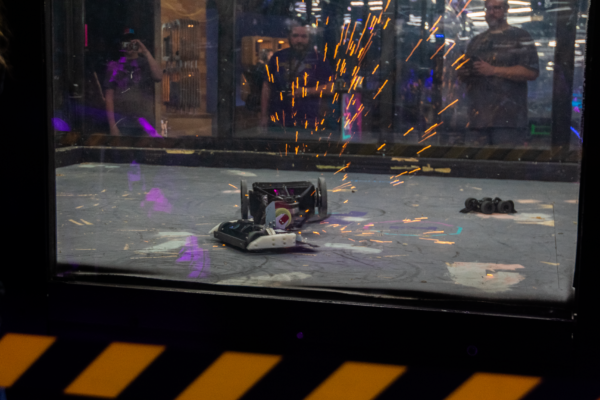Competitors ripped, tore, drilled, slashed, crushed and even immolated each other inside an unassuming brick building on Water Street in South Norwalk as the National Havoc Robot League (NHRL) hosted its championships in the three-, 12- and 30-pound weight classes at the NHRL.
Hundreds of people attended the competitions in person and thousands more around the world tuned into the livestreams. At the end of the all-day competition, the teams behind 30-pound wedge and vertical spinner equipped Emulsifier, UGEE the big wheeled 12-pound batterer and three-pound titanium-cleated Lynx each took home a “Golden Dumpster,” a brass plated miniature version of the NHRL’s boxy robotic referee “Brett.”

Each winning team was also able to direct $250,000 to a charity of their choosing. Those competitors who did not make it through the double elimination bracket were also able to send up to $5,000 to their chosen charity, totaling over $1 million in donations to STEM charities ranging from efforts to protect frogs to improving STEM education.
An additional $75,000 in cash prizes were awarded to competitors, as well as trophies honoring particularly impressive fights and records throughout the 2022 season.
Founder Austin McChord launched the NHRL in late 2018 while he was winding down his time as CEO of Datto, the cybersecurity and managed services company he founded. The inspiration for this pursuit was inspired by shows like “BattleBots.”
“I had attended a few other competitions and seen how they were run,” McChord explained, “and they were really at the hobbyist level. I thought that I could elevate that.”
The first NHRL event had only a single “cage” (a reinforced arena with double walled, inch thick plexiglass and a negative pressure fire suppression system) set up in a building sometimes described as McChord’s “secret lair.” Towards the end of 2019, he was looking to expand the NHRL even further when the pandemic hit. He said he was able to take advantage of the brief period where real estate values fell and purchased the former Klaff’s Furniture warehouse in South Norwalk from Spinnaker Realty during the “five-minute window where there were real estate deals.”
“It turns out we were the only people that were really having events during the pandemic since we own the space,” McChord said. “It’s easy for us to open all the windows and doors and do the airflow stuff that we needed to do to make sure people felt safe.”
Since then, McChord has built up both the building’s facilities and the staff of the NHRL. Now called the “House of Havoc,” the facility features six cages in various sizes, bleachers, and a VIP lounge. Several sets where commentators deliver color on fights in progress are operated from a full studio-grade camera control room. Spectators enter the venue through a museum featuring past champion robot fighters as well as a gift shop. SpaceCat Brewing, located near the NHRL site, sells an NHRL branded “Off-Kilter” NEIPA.
“I wouldn’t be surprised if it’s one of the bigger tourism draws for Norwalk,” McChord said, noting the NHRL is also looking for partnerships with local businesses.
For competitors there are also fully equipped machine shops outfitted with CNC machines, welding tools, and anything else they might need to bring their bot back into fighting shape between matches. According to McChord, it is in that space where the true face of the sport is revealed.
“Sort of the part you don’t get to see so much as a spectator is everything going on upstairs where all the builders have their pits. It’s such a collaborative environment, it feels more like the ‘Great British Baking Show’ than it does some scenario where everybody’s going after each other,” McChord said.
That emphasis on community is part of what prompted Sam Hanson, one of 10-15 NHRL full-time employees, to move to Norwalk from Baltimore to take up the role of “Evil Henchman,” his official job title.
“Part of what draws somebody to becoming an evil henchman is gadgets and toys, but you also have to love helping build the community that you’re part of,” Hanson said. “I’ve been seeing the same people here all that time and they’re my friends. To be able to lift everyone up through this just feels great.”
The facilities themselves were also a draw for Hanson, who recalled tournaments where nobody had their own power strip, let alone the plasma cutter and industrial lathes available to competitors at NHRL.
“There’s nothing else like this. In other fighting robot tournaments that you go to they’re in a maker space or an elementary school,” he said.
While Hanson’s responsibilities as a henchman are mainly technical, he is also responsible for NHRL social media content explaining the workings of the competition for audiences at home.
Kyle Crose serves both those watching the stream and in-person spectators by keeping up a steady stream of commentary during matches. He and the co-hosts of the podcast “Behind the Bots” all became members after Crose joined a chatroom on the Discord platform dedicated to the NHRL and saw an announcement about an opening for an announcer.
While it took some time to reach the point of having full camera crews and professionally built sets, Crose said that it all serves to set the NHRL apart.
“Most events, you might be able to find some cell phone videos of them on YouTube later,” Crose said while taking a break during the finals. “But to actually watch it live as it’s happening and get really excellent footage is something else. That has really driven the fan engagement and thus a lot of new builders have just got into this sport because of NHRL and because they see how accessible it is.”
“The community comes first,” he added. “There are very few people here that are competitors before they’re community members.”


















